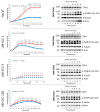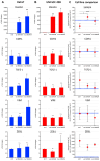The Role of TGF-β1 and Mutant SMAD4 on Epithelial-Mesenchymal Transition Features in Head and Neck Squamous Cell Carcinoma Cell Lines
- PMID: 39335144
- PMCID: PMC11429651
- DOI: 10.3390/cancers16183172
The Role of TGF-β1 and Mutant SMAD4 on Epithelial-Mesenchymal Transition Features in Head and Neck Squamous Cell Carcinoma Cell Lines
Abstract
The aim of the present study was to investigate possible differences in the sensitivity of HNSCC cells to known EMT regulators. Three HNSCC cell lines (UM-SCC-1, -3, -22B) and the HaCaT control keratinocyte cell line were exposed to transforming growth factor beta 1 (TGF-β1), a known EMT master regulator, and the cellular response was evaluated by real-time cell analysis (RTCA), Western blot, quantitative PCR, flow cytometry, immunocytochemistry, and the wound closure (scratch) assay. Targeted sequencing on 50 cancer-related genes was performed using the Cancer Hotspot Panel v2. Mutant, and wild type SMAD4 cDNA was used to generate recombinant SMAD4 constructs for expression in mammalian cell lines. The most extensive response to TGF-β1, such as cell growth and migration, β-actin expression, or E-cadherin (CDH1) downregulation, was seen in cells with a more epithelial phenotype. Lower response correlated with higher basal p-TGFβ RII (Tyr424) levels, pointing to a possible autocrine pre-activation of these cell lines. Targeted sequencing revealed a homozygous SMAD4 mutation in the UM-SCC-22B cell line. Furthermore, PCR cloning of SMAD4 cDNA from the same cell line revealed an additional SMAD4 transcript with a 14 bp insertion mutation, which gives rise to a truncated SMAD4 protein. Overexpression of this mutant SMAD4 protein in the highly epithelial control cell line HaCaT resulted in upregulation of TGF-β1 and vimentin. Consistent with previous reports, the invasive and metastatic potential of HNSCC tumor cells appears associated with the level of autocrine secretion of EMT regulators such as TGF-β1, and it could be influenced by exogenous EMT cytokines such as those derived from immune cells of the tumor microenvironment. Furthermore, mutant SMAD4 appears to be a significant contributor to the mesenchymal transformation of HNSCC cells.
Keywords: SMAD4; TGF-β1; epithelial–mesenchymal transition; head and neck squamous cell carcinoma.
Conflict of interest statement
The authors declare no conflicts of interest.
Figures







Similar articles
-
[Effect of disulfiram on epithelial-mesenchymal transformation of oral squamous cell carcinoma cells].Shanghai Kou Qiang Yi Xue. 2020 Apr;29(2):138-145. Shanghai Kou Qiang Yi Xue. 2020. PMID: 32626875 Chinese.
-
Incomplete epithelial-mesenchymal transition in p16-positive squamous cell carcinoma cells correlates with β-catenin expression.Anticancer Res. 2014 Dec;34(12):7061-9. Anticancer Res. 2014. PMID: 25503133
-
CD147 mediates transforming growth factor-β1-induced epithelial-mesenchymal transition and cell invasion in squamous cell carcinoma of the tongue.Exp Ther Med. 2019 Apr;17(4):2855-2860. doi: 10.3892/etm.2019.7230. Epub 2019 Jan 31. Exp Ther Med. 2019. PMID: 30906472 Free PMC article.
-
C4.4A as a biomarker of head and neck squamous cell carcinoma and correlated with epithelial mesenchymal transition.Am J Cancer Res. 2015 Nov 15;5(12):3505-15. eCollection 2015. Am J Cancer Res. 2015. PMID: 26885441 Free PMC article. Review.
-
Regulation of extracellular matrix remodeling following transforming growth factor-beta1/epidermal growth factor-stimulated epithelial-mesenchymal transition in human premalignant keratinocytes.Cells Tissues Organs. 2007;185(1-3):116-22. doi: 10.1159/000101312. Cells Tissues Organs. 2007. PMID: 17587817 Review.
References
-
- Makarova G., Bette M., Schmidt A., Jacob R., Cai C., Rodepeter F., Betz T., Sitterberg J., Bakowsky U., Moll R., et al. Epidermal growth factor-induced modulation of cytokeratin expression levels influences the morphological phenotype of head and neck squamous cell carcinoma cells. Cell Tissue Res. 2012;351:59–72. doi: 10.1007/s00441-012-1500-y. - DOI - PubMed
LinkOut - more resources
Full Text Sources
Research Materials
Miscellaneous

